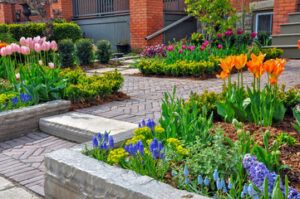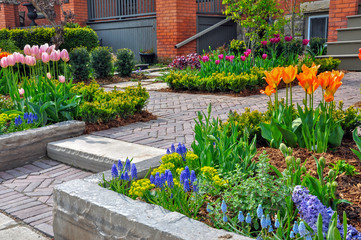Jupiter Landscaping enhances the beauty and functionality of outdoor spaces. Thoughtful design transforms a plain yard into a relaxing retreat. Strategic plant placement creates balance and harmony. A well-maintained landscape increases property value and curb appeal.
Choosing the right plants ensures long-term success. Native species thrive in local climates and require less maintenance. Layering plants of different heights adds depth and texture. Grouping plants with similar needs simplifies care routines.
Water-efficient landscaping reduces maintenance and supports sustainability. Drought-tolerant plants require less water and stay vibrant. Mulching retains moisture and prevents weed growth. Smart irrigation systems improve water efficiency.
Outdoor lighting extends the usability of the space. Soft pathway lights create a welcoming glow. Spotlights highlight architectural features and plants. Layered lighting enhances depth and safety.
Hardscaping elements add structure and function. Paved walkways define movement patterns. Stone borders create visual separation between plant beds. Textured surfaces improve traction and durability.
Seating areas increase comfort and usability. Built-in benches offer permanent seating. Freestanding furniture allows flexibility in layout. Thoughtful placement encourages relaxation and conversation.
Shade structures improve comfort during warm weather. Pergolas provide filtered light and protection. Canopies offer flexible coverage. Natural shade from trees enhances the organic feel.
Garden beds add color and visual interest. Raised beds improve soil drainage and accessibility. Curved edges soften the overall design. A mix of annuals and perennials maintains year-round interest.
Edging defines spaces and improves organization. Clean lines separate grass from flower beds. Stone or metal borders create a polished look. Consistent edging enhances visual flow.
Incorporating water features increases tranquility. Fountains provide soothing sounds and movement. Reflecting pools create a sense of calm. Proper circulation prevents stagnation and algae growth.
Planting for privacy enhances relaxation. Tall hedges create natural barriers. Climbing vines soften fences and walls. Layered planting maintains an organic feel while increasing seclusion.
Seasonal planting ensures year-round vibrancy. Blooming flowers in spring and summer add color. Evergreen shrubs maintain structure in winter. Thoughtful plant selection balances seasonal changes.
Low-maintenance designs reduce upkeep. Ground covers prevent erosion and minimize weeds. Mulched beds reduce watering needs. Native plants require less pruning and fertilization.
Wildlife-friendly landscaping supports the ecosystem. Pollinator-friendly plants attract bees and butterflies. Bird feeders and baths encourage avian activity. Balanced plant diversity creates a thriving environment.
Functional zoning improves the flow of outdoor spaces. Dining areas encourage gatherings. Play zones provide safe spaces for children. Separate garden beds create distinct areas for relaxation and activity.
Soil health determines plant success. Adding compost improves nutrient levels. Proper aeration enhances root growth. Testing pH levels ensures balanced soil conditions.
Windbreaks protect plants and improve comfort. Dense shrubs reduce wind intensity. Strategic tree placement creates natural barriers. Layered planting enhances protection without sacrificing aesthetics.
Mixing textures enhances visual interest. Smooth paving contrasts with rough stone walls. Soft grass balances rigid hardscaping. Layered textures create depth and variety.
Climbing plants maximize vertical space. Trellises support vines and flowers. Wall-mounted planters add greenery without consuming ground space. Vertical gardens improve air quality and reduce heat retention.
Ground covers reduce maintenance and improve appearance. Low-growing plants prevent soil erosion. Creeping varieties fill gaps between stones. Evergreen options provide year-round color.
Creative color schemes enhance visual harmony. Warm tones create an inviting feel. Cool shades promote relaxation. Coordinated color palettes maintain balance and cohesion.
Balanced symmetry creates a polished look. Matching plant heights and shapes improve visual flow. Mirrored planting patterns create harmony. Subtle variations maintain a natural feel.
Incorporating art adds personality to the landscape. Sculptures create focal points. Decorative stones add texture and contrast. Art pieces reflect personal style and taste.
Eco-friendly landscaping minimizes environmental impact. Rain gardens capture runoff and reduce flooding. Permeable paving improves groundwater recharge. Recycled materials support sustainability.
Outdoor kitchens increase functionality. Built-in grills and countertops create cooking zones. Thoughtful layouts improve convenience. Proper ventilation and drainage maintain long-term performance.
Smart landscaping integrates technology. Automated irrigation systems adjust based on weather conditions. Solar-powered lights reduce energy consumption. Motion sensors enhance security and usability.
Perennial plants reduce replanting needs. Hardy species return year after year. Mixed varieties ensure continuous blooms. Proper spacing prevents overcrowding and improves airflow.
Fire features enhance warmth and ambiance. Fire pits provide a gathering point. Built-in fireplaces add permanence and style. Heat-resistant materials improve safety and durability.
Pet-friendly landscaping enhances usability. Durable grass withstands activity. Non-toxic plants ensure safety. Fenced areas provide secure play zones.
Decorative mulch improves appearance and soil health. Organic varieties enhance moisture retention. Colored options create visual contrast. Proper depth prevents weed growth and compaction.
Layering plants enhances depth and texture. Tall shrubs provide a backdrop. Mid-sized plants create structure. Ground covers fill gaps and soften edges.
Strategic tree placement improves shading and aesthetics. Deciduous trees provide summer shade and winter sunlight. Evergreen options maintain structure year-round. Proper pruning ensures balanced growth.
Rock gardens add texture and low-maintenance appeal. Mixed stone sizes create visual interest. Hardy succulents thrive in rocky conditions. Proper drainage prevents water accumulation.
Pathway designs improve movement and flow. Curved paths create a natural feel. Straight lines enhance formality. Textured materials improve traction and durability.
Privacy screens increase seclusion without closing off the space. Lattice panels support climbing plants. Freestanding screens allow flexibility. Natural barriers blend with the landscape.
Rainwater collection supports sustainable watering. Barrels capture runoff for reuse. Proper filtration prevents debris buildup. Stored water reduces reliance on municipal supplies.
Terraced landscaping improves elevation changes. Retaining walls prevent soil erosion. Stepped planting beds create depth. Layered design enhances movement and visual flow.
Native plants enhance biodiversity. Local species attract pollinators and wildlife. Adapted plants require less water and care. Balanced planting supports a stable ecosystem.
Fragrance gardens engage multiple senses. Aromatic herbs create soothing scents. Night-blooming flowers enhance evening ambiance. Balanced placement maintains air circulation.
Modern landscape lighting improves safety and style. Motion sensors increase security. Soft LED lights enhance energy efficiency. Strategic placement highlights key features.
Water-efficient planting reduces maintenance. Grouping plants with similar needs simplifies watering. Drought-tolerant species reduce water use. Mulch retains moisture and improves soil health.
Outdoor storage increases organization and functionality. Hidden compartments keep tools accessible but out of sight. Weatherproof materials ensure durability. Proper placement maintains flow and aesthetics.
Colorful foliage adds vibrancy without relying on flowers. Variegated leaves create contrast. Seasonal changes enhance visual interest. Balanced combinations maintain cohesion.
Container gardening increases flexibility. Mobile planters allow seasonal adjustments. Mixed heights and colors create visual depth. Self-watering containers reduce maintenance.
Strategic pruning maintains plant health and shape. Removing dead growth improves airflow. Controlled shaping enhances symmetry. Balanced cutting encourages new growth.
Balanced scale creates visual harmony. Large plants provide a focal point. Smaller varieties fill gaps and soften edges. Layered sizes maintain flow and proportion.
A well-designed landscape reflects both style and function. Thoughtful plant selection enhances long-term health. Balanced design improves usability and appearance. Proper maintenance ensures lasting appeal.

